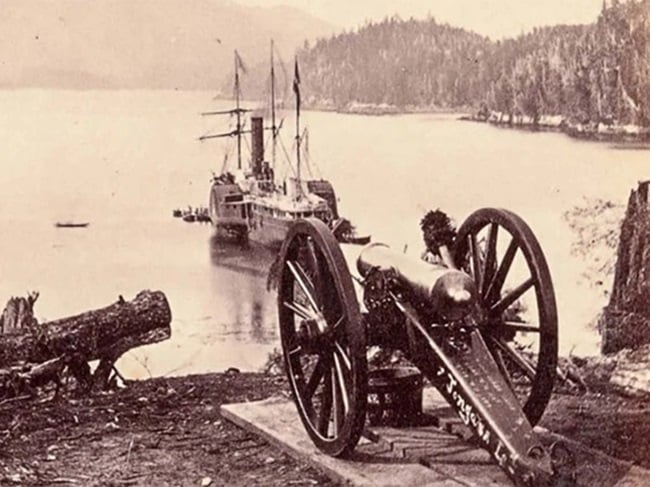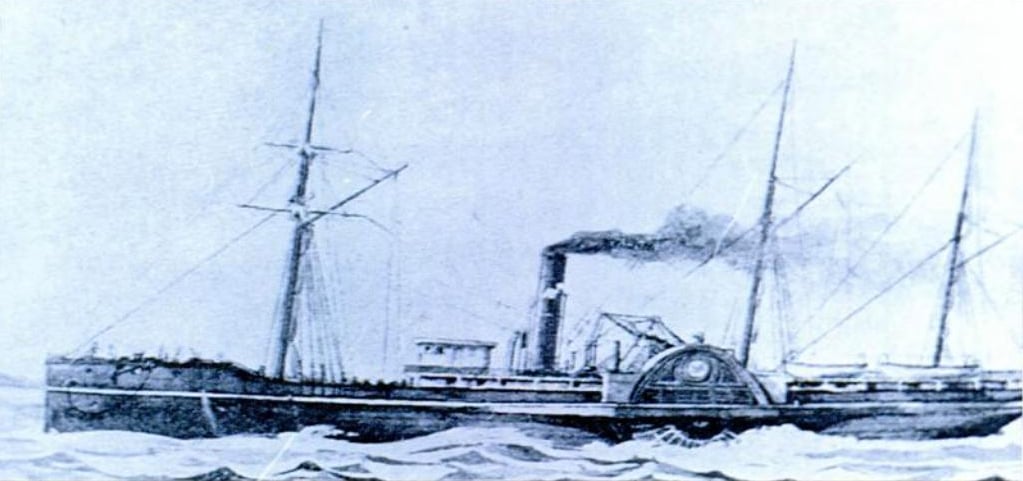
An estimated 4,000 ounces of gold believed to be on board a ship that sank off of the British Columbia coast in 1875 remains unclaimed 150 years after the disaster.
SS Pacific was a wooden sidewheel steamer built in 1850 most notable for its sinking in 1875 as a result of a collision southwest of Cape Flattery, Washington. Pacific had an estimated 275 passengers and crew aboard when she sank. Only two survived.
Among the casualties were several notable figures, including the vessel’s captain at the time of the disaster, Jefferson Davis Howell (1846–1875), the brother-in-law of former Confederate President Jefferson Davis. The sinking of the Pacific killed more people than any other marine disaster on the West Coast at the time.
Passengers also included gold miners going home before the snows hit their diggings in northern British Columbia, and forty-one unidentified “Chinamen.” While the official estimate was that there were 275 people aboard, there is no way to be sure, and the number of passengers may have been higher.
Pacific’s cargo included at least two hundred pounds (91 kg) of gold, sparking the interest of treasure hunters.

No takers for the gold on the sunken ship
A hundred and fifty years later, there have been no takers for long-lost gold found on the sunken ship. A spokesman for the Northwest Shipwreck Alliance said there were no supported claims made by the descendants of any of the passengers or crew.
In November 2022, it was revealed through documents lodged in the U.S. district court in Seattle that the wreck of the seventy-meter, wooden, coal-powered sidewheeler had been found by a U.S. salvage company called Rockfish Inc.
Rockfish had been searching for the wreck and its golden bounty since 2016 using sonar and a towed camera sled. The search site was selected based on records from 1875 that show the ship went down southwest of Cape Flattery at the edge of the Olympic Peninsula. This was also according to more recent information from commercial fishermen who noted that their trawling gear was getting caught up on something on the ocean floor.
Based on court records, “the location of the wreck site, dimensions of the wreck, presence of a pair of eight-meter circular objects in the debris field consistent with the dimensions of S.S. Pacific’s paddle wheels, and the presence of coal in the debris field, Rockfish believes the vessel is the wreck of the S.S. Pacific.”
Those court records stated the wreck was located over 1,600 feet deep on the western edge of the Juan de Fuca Strait. By comparison, the Titanic sits at a depth of over 13,000 feet in the Atlantic Ocean.
Under maritime law, Rockfish won court approval to salvage what it could from the wreckage, saying it would be used to create a maritime museum in cooperation with the Northwest Shipwreck Alliance.
However, this was granted on the condition that the company acknowledge the law of finds, which entitles descendants of a person who carried gold on the ship to claim that gold. If the claim is granted by the court, the claimant would have to pay Rockfish a fee for recovering the gold.
Related: Billions Worth of Gold May Be Hidden in an Abandoned California Mine